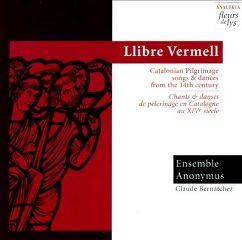Libre Vermell: Catalonian Pilgrimage songs and dances from the 14th century (1995)
Libre Vermell: Catalonian Pilgrimage songs and dances from the 14th century (1995)

1 O virgo splendens 3:02 2 Stella Splendens 6:02 3 Imperaytriz de la ciutat joyosa 2:35 4 Laudemus Virginenem 3:31 5 Mariam matrem virginem 3:07 6 Splendens ceptigera 2:36 7 Dannse en rond 2:24 8 Los set goyts 8:48 9 Cuncti simus concanentes 5:27 10 Polorum regina 5:40 11 Splendens ceptigera 7:04 12 Laudemus virginem 5:17 13 Ad mortem festinamus 8:09 14 O virgo splendes 2:49 Claude Bernatchez - Arranger, Bells, Carillon, Conductor, Fiddle, Violin, Zarb Jeanne Bovet - Mezzo-Soprano Andrew Clayden - Percussion, Sackbut Elise Guay - Flute, Recorder Pierre Langevin - Bagpipes, Dulcimer, Flute, Organ, Psaltery, Recorder, Timpani Nicolas Lemieux - Bass Alfred Marin - Tenor Gary Nagels - Sackbut, Tambourine Guy Ross - Lute, Tenor, Ud Ensemble Anonymus Libre Vermell
Catalonian music in the 14th century
Located in the North-East of Spain and stretching from the Mediterranean Sea to the Pyrenees, Catalonia was influenced by the long presence of the Moors on its territory and by its excellent geographical position at the junction of the great artistic and scientific currents of Middle Age Europe. A cultural bloom which marked, as early as the 14th century, the beginning of a genuine Renaissance.
The Court of Barcelona was famous for the refinement and generosity of its patrons. From Jacques II (1291-1327) to Martin the First (1396-1410), the most celebrated musical leaders of France, Italy, Flanders and Germany brought with them Philippe de Vitry's new techniques of the Ars Nova. They thus contributed to the creation of an outstanding artistic center in the Aragon Court, where all musical styles came together in a high level of excellence. A living proof of this achievement is the existence of the Llibre Vermell of Montserrat.
The Llibre Vermell
The Llibre Vermell, which is kept at the library of Montserrat Abbey, is surely one of the most precious and famous manuscripts of the end of the 14th Century. It is thanks to the monks who had lent the manuscript to the Marquis de Lio, of the Académie des Belles Lettres in Barcelona, that the manuscript was saved from a terrible fire which completely destroyed the archives of Montserrat during Napoleon's invasion of 1811. The manuscript was given back in 1885, henceforth bound in the red velvet that gave it the name: Llibre Vermell (Vermilion Book). It was with the intention of entertaining and educating the pilgrims who came to pray to the Black Virgin — in the shape of a wooden 12th-century Romanesque statue — that the monks of the Montserrat Abbey composed, beside diverse texts, ten songs devoted to the Virgin, except for the last one, Ad mortem festinamus, which is a dance of death.
The collection opens with O Virgo splendens which, constructed in the form of a "caça” like the Laudemus Virginem and Splendens ceptigera, illustrates perfectly the mastery of the intricacies of the medieval canon. The reference "caça de duobos vel tribus,” written in the margin, indicates that the canons may be sung by two or three voices. Moreover, Los set goyts and Imperaytritz de la ciutat joyosa are written in the catalan language of the people, the rest of the work being in latin. The reference "a ball redon” (round dance) at the beginning of Los set goyts, Cuncti simus concanentes and Polorum regina, is related to the tradition of sacred dancing — very popular in the Montserrat Abbey, despite various councils' condemnations of its excesses.
These dancing songs, which subtly line up chorus and verse, are in the form of the Italian ballad for Los set goyts, and of the French "virelai” for Stella splendens, Cuncti simus concanentes, Polorum regina, Mariam Matrem Virginem, and Ad mortem festinamus. Finally, Mariam Matrem Virginem is, with Imperaytritz de la ciutat joyosa and Stella splendens, a summit of polyphonic writing in this collection and, without a doubt, one of the most beautiful melodies left by the Catalonian Middle Age.
The interpretation
Places of pilgrimage have always been a symbol of sacred human experiences, an "encounter” with the "beyond.” The pilgrim's journey, a genuine bodily combat with the physical environment, is a symbol of transformation and mutation. It is a ritual which calls for an inner dialogue, sublimating the pilgrim's act into a fundamental change, the "renaissance” of the individual. In our interpretation of the Llibre Vermell, we propose adding a poetic structure to this precious collection that is inspired by its historical and traditional context. Between each of the ten songs presented in the original order of the manuscript, we have added an instrumental contrafactum (counterfeit) which progresses in the opposite order. By using such medieval compositional methods as the contrafactum, occurence and recurrence, we wish to evoke, through the resulting arch-like forms, the symbolic progress of the pilgrim. ---Claude Bernatchez, analekta.com
download: uploaded filecloudio anonfiles yandex 4shared mediafire solidfiles mega nornar








